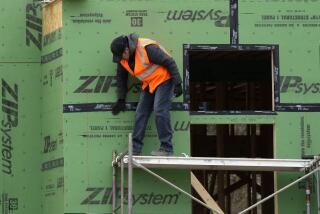Slack growth at factories, service firms
- Share via
Growth in the service sector slowed as expected in December and new factory orders rose at a disappointing pace the previous month, according to reports released Thursday, pointing to a slackening economy.
Analysts said that although the reports painted a picture of an economy treading water, the Federal Reserve probably would hold interest rates unchanged in early 2007 as it monitored the cooling housing market for a larger-than-expected effect on growth.
The Institute for Supply Management said its service index slipped to 57.1 in December from 58.9 in November. This was in line with market expectations for a 57 reading. A number above 50 indicates growth in the sector.
The service sector makes up about 80% of U.S. economic activity, including businesses such as restaurants, hotels, hair salons, banks and airlines.
“It’s not pointing to the re-acceleration that some are expecting out there. This fits with the story of moderate growth. The Fed will see this consistent with its policy on hold,” said Keith Hembre, chief economist at FAF Advisors in Minneapolis.
Supporting the view of a slowing economy was the 0.9% rise in November factory orders, below the market’s consensus outlook for a 1.4% gain.
In October, new orders declined a revised 4.5%, the Commerce Department said, versus a previous estimate of 4.7%. Excluding transportation, November factory orders fell 0.5%.
Orders for nondefense capital goods excluding aircraft, seen as a gauge of business spending, fell 1.1% after a 4% fall the previous month. The last time the measure fell for two consecutive months was February and March 2005.
Consumers also appear to be showing signs of fatigue. Retailers posted disappointing December sales, marking the third consecutive month of weak growth, according to research firm Retail Metrics. It said 10 retailers lowered their earnings forecasts.
Housing and jobless claims data released Thursday, however, painted a slightly different picture.
The National Assn. of Realtors said its pending home sales index, based on contracts signed in November, fell to 107 from 107.5 in October but held above July’s trough. The reading had been forecast at 108.
“The index is pointing toward fairly stable home sales in the near future,” David Lereah, chief economist for the trade association, said in a statement. “That is another indicator that home sales likely bottomed out in September.”
The number of workers applying for initial jobless benefits edged up 10,000 to 329,000 in the week ended Saturday, beating market expectations. But analysts said that the figure had been distorted by the holidays and that the job market remained stable.
The prior week’s jobless claims were revised up to 319,000 from a preliminary 317,000.
Wall Street economists had forecast that claims in the week ended Saturday would be a seasonally adjusted 318,000.
Backing the view of a stable labor market was an independent report showing that planned layoffs fell 29% in December from the previous month. Planned job cuts for all of 2006 fell below 1 million for the first time since 2000, according to Challenger, Gray & Christmas, an employment consulting firm.
Nonfarm payroll data for December, due to be released this morning, will provide a clearer picture of the labor market.
More to Read
Inside the business of entertainment
The Wide Shot brings you news, analysis and insights on everything from streaming wars to production — and what it all means for the future.
You may occasionally receive promotional content from the Los Angeles Times.










